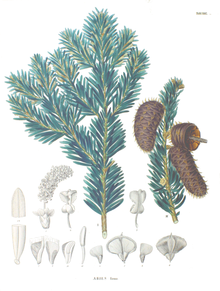Momi fir
| Momi fir | ||||||||||||
|---|---|---|---|---|---|---|---|---|---|---|---|---|

Momi-Fir ( Abie's company ) |
||||||||||||
| Systematics | ||||||||||||
|
||||||||||||
| Scientific name | ||||||||||||
| Abie's company | ||||||||||||
| Sieve. & Zucc. |
The momi fir ( Abies firma ) is a species of the firs ( Abies ) and the pine family (Pinaceae). It only occurs in Japan .
description
The momi fir is an evergreen tree that can grow up to 50 meters in height and up to 2 meters in diameter at chest height . The long branches descend horizontally or ascendingly from the straight trunk. In young trees, the crown is broadly pyramidal to dome-shaped. It flattens out more with age. The smooth bark is greyish in color and usually shows resin bubbles when young. With age, the bark becomes darker and tears open. The bark of the branches is yellowish-green to gray-brown. It can be covered in fine black hair or completely hairless.
The gray-brown buds are around 10 millimeters long and 5 millimeters thick. They are oval to conical in shape and slightly resinous. Young needles are divided into two parts and have a sharp point. They are mainly found near the trunk of old trees. Older needles are twisted at the base and have a blunt or notched point. The top of the needle is grooved while the bottom is keeled. The color is dark green on the upper side of the needle, while the underside of the needle has a blue-green-yellowish color. The needles are usually arranged in a comb shape on the branches. There are 12 to 13 rows of stomata on the underside of the needle .
The flowering period extends from April to May. The cylindrical, male cones are yellowish in color and are around 2.5 to 3 centimeters in size. They are found individually hanging on the leaf axils. The green to yellow colored female cones are broad oval to conical in shape and rounded at the tip. The cones ripen in October. Ripe cones are yellowish-brown in color and are 8 to 15 inches long and 3 to 5 inches thick. The light brown seeds are 6 to 8 millimeters long and have a 10 to 15 millimeter long, brown wing.
The number of chromosomes is 2n = 24.
Distribution and location
The original distribution area of the momi fir includes the Japanese islands of Honshū , Shikoku , Kyushu and Yakushima . The tree species grows at altitudes of 50 to 1900 meters. The annual rainfall is over 1000 mm.
Pure stands are only very rarely formed and then usually grow on dry locations. Mixed stands are mainly with other conifer species such as the Nikko fir ( Abies homolepis ), the Hinoki cypress ( Chamaecyparis obtusa ), the Japanese cedar ( Cryptomeria japonica ), the Japanese red pine ( Pinus densiflora ), the girl-pine ( Pinus parviflora ,) the Japanese Douglas fir ( Pseudotsuga japonica ), the umbrella fir ( Sciadopitys verticillata ), the Japanese nut slice ( Torreya nucifera ) and the southern Japanese hemlock ( Tsuga Sieboldii ) but also with deciduous trees such as Carpinus laxifolia , the Japanese chestnut ( Castanea crenata ), the curb Beech ( Fagus crenata ), the Japanese beech ( Fagus japonica ) and various types of oak ( Quercus ).
use
The wood is used as construction wood and to make coffins. Outside of Japan, the species is often planted as a garden and park tree.
Systematics
The Abies firma is within the genus of the fir ( Abies ) of the section Momi and the lower section company e assigned. It was first described as an Abies company in 1848 by the two German botanists Philipp Franz von Siebold and Joseph Gerhard Zuccarini .
Hazard and protection
The species is listed as "not endangered" in the IUCN Red List . However, it is pointed out that a renewed examination of the hazard is necessary.
swell
- Roger Phillips: The great cosmos nature guide trees . Franckh-Kosmos, Stuttgart 1998, ISBN 3-440-07503-6 , pp. 62 .
- Christopher J. Earle: Abie's company. In: The Gymnosperm Database. Retrieved November 2, 2010 .
Individual evidence
- ↑ a b c d e f g Christopher J. Earle: Abie's firm. In: The Gymnosperm Database. Retrieved November 2, 2010 .
- ↑ a b Liguo Fu, Nan Li, Thomas S. Elias, Robert R. Mill: Abies firma . In: Wu Zheng-yi, Peter H. Raven (Ed.): Flora of China . Volume 4: Cycadaceae through Fagaceae . Science Press / Missouri Botanical Garden Press, Beijing / St. Louis 1999, ISBN 0-915279-70-3 , pp. 48 (English).
- ^ Tropicos. [1]
- ↑ Abies firma in the endangered Red List species the IUCN 2006. Posted by: Conifer Specialist Group, 1998. Retrieved on November 4 of 2010.
